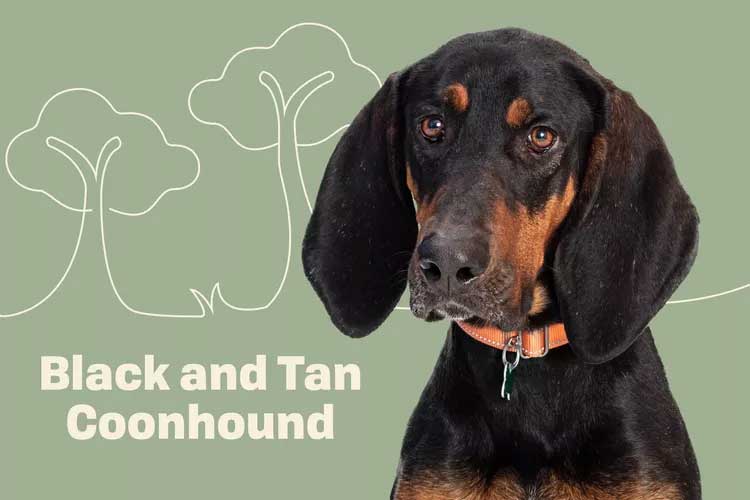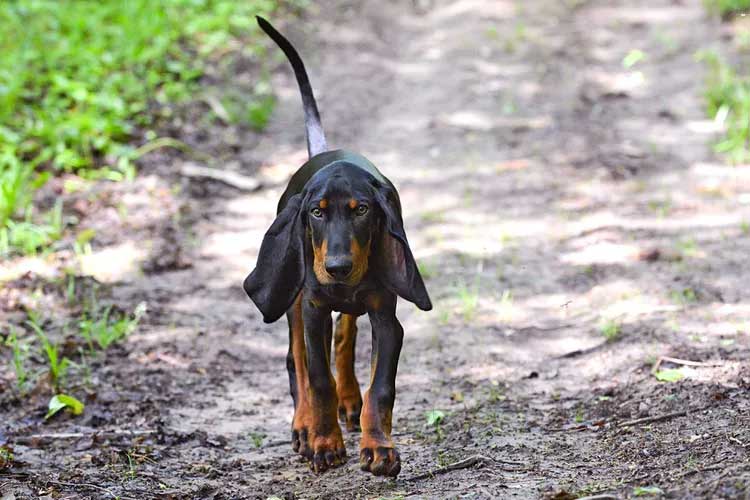Black and tan coonhounds are gentle family dogs, but don’t mistake their calm demeanor as laziness. These hounds are active hunting dogs and want to put their super-sensitive nose to work.

Black and Tan Coonhound Overview
| OFFICIAL NAME | Black and Tan Coonhound |
| COMMON NAME | Black and Tan Coonhound |
| PET HEIGHT | 23 to 27 inches |
| PET WEIGHT | 65 to 110 pounds |
| LIFESPAN | 10 to 12 years |
| GOOD WITH | children, dogs, families |
| TEMPERAMENT | friendly, gentle, willful |
| INTELLIGENCE | high |
| SHEDDING AMOUNT | occasional |
| EXERCISE NEEDS | high |
| ENERGY LEVEL | active |
| VOCAL LEVEL | howler |
| DROOL AMOUNT | medium |
| BREED GROUP | hound |
| BREED SIZE | large (61-100 lbs.) |
| COAT LENGTH | short |
| COLORS | black, brown / chocolate / liver |
| PATTERNS | black and tan |
| OTHER TRAITS | easy to groom, good hiking companion, high prey drive, loves water, prone to health issues |
The perfect mix of homebody and adventurer, a black and tan coonhound is a hound dog fit for wide-open spaces where he can put his nose to good use and sing into the sunset.
Developed in the U.S. after the Revolutionary War, black and tans became go-to hunting partners for settlers, even earning the nickname "settlers' dogs." And while this intelligent breed still thrives in the hunting field (thanks to their incredibly powerful noses), black and tan coonhounds shine as family dogs. As long as he has scritches and pats, plus vast space to roam and sniff, he'll be one happy pup.
Appearance
Take one look into a black and tan coonhound's expressive eyes and you'll immediately see how sweet these souls are. With their big black sniffers, tan eyebrows to accentuate those puppy dog eyes, a slightly wrinkled face, and long ears that cascade down either side of their face like black velvet curtains, these handsome boys will sniff out and steal your heart.
Black and tan coonhound puppies look adorably out of proportion with oversized paws and ears that hang down to their shoulders. But these large hound dogs grow to stand 23–27 inches tall at the shoulder and can weigh up to 110 pounds. Though they might look like they'd lumber around (especially as puppies, their big paws perhaps tripping over their ears), black and tan coonhounds are agile and swift, bred for pursuing big game and treeing smaller prey.
Their deep black coat is short and dense over their muscular frame, with tan accents on their eyebrows, muzzle, chest, legs. Sometimes, they can have a small touch of white on their chest or elsewhere in their fur.
Temperament
Though every dog is an individual, the typical black and tan coonhound temperament is friendly, laid-back, and social. They love being around people, are patient and calm around children, and are a good fit for active families—or in homes where they have plenty of room to exercise their lanky legs.
Because they were bred to hunt, black and tans have a high prey drive, says Sarah Wooten, DVM, veterinary expert for Pumpkin Pet Insurance. Wooten points out that these coonhounds "may not be good with cats, birds, or pocket pets." But they do tend to get along well with other doggie siblings!
Your pooch might also be a little reserved or shy around strangers, but socializing your black and tan coonhound puppy will help him be more confident and friendly when meeting new people.
Though these pups have big brains, owners should be prepared for their black and tan coonhound's "puppy phase" to last a longer than anticipated.
"These dogs take a surprisingly long time to mentally mature—up to three years!" Wooten says. "So even though an owner may think their 2-year-old black and tan should be acting more mature, in essence, they're still a puppy. So be patient!"
Living Needs
Black and tan coonhounds have been bred for generations to sniff out and trail their prey, so having a tall, sturdy fence is a must. According to the American Black and Tan Coonhound Club (ABTCC), these hounds will follow their nose for miles without realizing exactly how far they're straying from home. Always make sure your dog is microchipped and that the information is up-to-date, in case he slips out of your yard in pursuit of a curious smell. And while they may beg to run free with those big ol' puppy dog eyes—never let your black and tan off-leash.Once they capture a scent, these dogs become hyper-focused, and it can be nearly impossible to divert their attention from the trail they're tracking. Because of this, a black and tan coonhound might not be the best option for a first-time dog owner.
When it comes to his home, a black and tan coonhound needs room to run, follow his nose, and explore. He won't be happy in a city apartment, and might not even do well in the suburbs or anywhere else with nearby neighbors. The black and tan coonhound bark is more of a bay, and his frequent howls don't exactly comply with quiet hours. His dream home is somewhere with vast acreage where he can roam and vocalize.

Those howls can also come out if he's left alone for too long, as these social dogs love being around their family. So if you're going on a day hike or morning run, take your black and tan coonhound with you! He'll especially love a chance to work as your hunting partner—and his nose never misses a scent.
While he'll want to spend the day roaming, no dog, including the black and tan coonhound, should be kept outside 24/7. He's a great family dog after all—and will want to lie beside you during movie night.
Care
Grooming a black and tan is about as low-maintenance as you can get. As long as you brush him twice a week (Wooten recommends using a hound mat or stiff bristle brush) and give him a bath when he gets stinky, he'll be good. His short fur sheds minimally year-round, but is easily kept under control with regular brushing.
Like all dog breeds, their nails should be trimmed regularly and they need consistent tooth brushing, too. But his ears are where you'll spend the most time with grooming needs—coonhound ears are characteristically long and floppy, making them prone to infections. Wooten says owners should clean their black and tan coonhound's ears weekly with a pH-balanced ear cleanser. And because many black and tans like to swim, their ears should always be cleaned shortly after to absorb extra moisture that can develop into a yeast infection or other issue.
These dogs need at least an hour of vigorous exercise each day, Wooten says, but black and tan coonhound puppies should play and romp around as they please without a high-impact exercise routine.
"Do not take black and tans jogging until they are 2 years of age because they are still growing," Wooten says. "The excessive pounding on their growth plates can cause damage to growing bones."

Black and tan coonhound training should start early and remain consistent throughout their lives. These pups can be willful and are inclined to follow their natural instinct to hunt and chase, so Wooten recommends rewarding them with positive reinforcement, working with a professional trainer, and joining puppy kindergarten.
"The main issue is their prey drive and their need to wander," Wooten says. "A black and tan will bolt if he picks up on a scent trail or if he sees something he wants to chase."
His nose is so perceptive that keeping your pup's attention during training sessions might cause a headache. But take a deep breath and remember: Patience, perseverance, and positive reinforcement.
Health
The lifespan of a black and tan coonhound is typically between 10–12 years. Like all breeds, these pups can be susceptible to certain health problems. While not every black and tan will develop these issues, Wooten says owners should be vigilant for:Hip dysplasia: This is a condition where a dog's hip joint doesn't develop properly, leading to a loose joint and, if untreated, osteoarthritis.
Ear infections: With their floppy ears, black and tan coonhounds are prone to ear infections, particularly otitis externa. If your hound's ears look red, make an appointment with your veterinarian.
Ectropion: Though their droopy eyelids add to a black and tan's sweet expression, they can roll out and cause dryness and irritation.
Hypothyroidism: Low thyroid levels can cause your pup to be sluggish, overweight, and even cause skin or neurological problems.
Bleeding disorders: Black and tan coonhounds can haveHemophilia B, which can cause spontaneous bleeding. Because of this, the breed might have problems with blood clotting after injuries or surgeries. Be vigilant and consult your vet for best prevention practices.
Cataracts: This can cause blindness as your pup ages.
"To ensure a black and tan isn't susceptible to these conditions, genetic testing is recommended," Wooten says. "In addition, ensure breeders provide proof their puppies are free of these conditions, and ask for a health guarantee."
If you're adopting through a black and tan coonhound rescue, ask for all available health information about your pooch so that you and your vet can be on the lookout for potential issues throughout their life.

History
The black and tan coonhound is an all-American breed, according to the ABTCC. Their ancestors include dogs who sailed across the pond following the American Revolution. These early iterations were mishmashes of English hounds, possibly including bloodhounds, foxhounds, the Kerry beagle, the Grand Bleu Gascogne, and the now-extinct Talbot hound.In the States, the breed was refined and perfected to be the ultimate American hunting dog for the working class, according to the Coon Hunting Club (CHC). They were used to "tree" raccoons, meaning they chased their prey up a tree and barked, alerting their human hunting partners as to where the coons were cornered. You know those classic pioneer racoon fur caps? A black and tan coonhound probably chased it up a tree.
Raccoons aren't the only animals black and tans would chase—the breed has even been used to hunt bears, according to the CHC. And to this day they're still an ideal hunting partner.
Black and tan coonhounds were officially recognized by the United Kennel Club in 1912, and the American Kennel Club registered the breed shortly after, in 1945.
Fun Facts
The black and tan coonhound was the first coonhound recognized by the AKC. They're one of six coonhound breeds; others are the Treeing Walker coonhound, the redbone coonhound, the English coonhound, the bluetick coonhound, and the Plott coonhound.Though he was reimagined for the Disney film, Chief is a black and tan coonhound in the 1967 novel The Fox and the Hound.